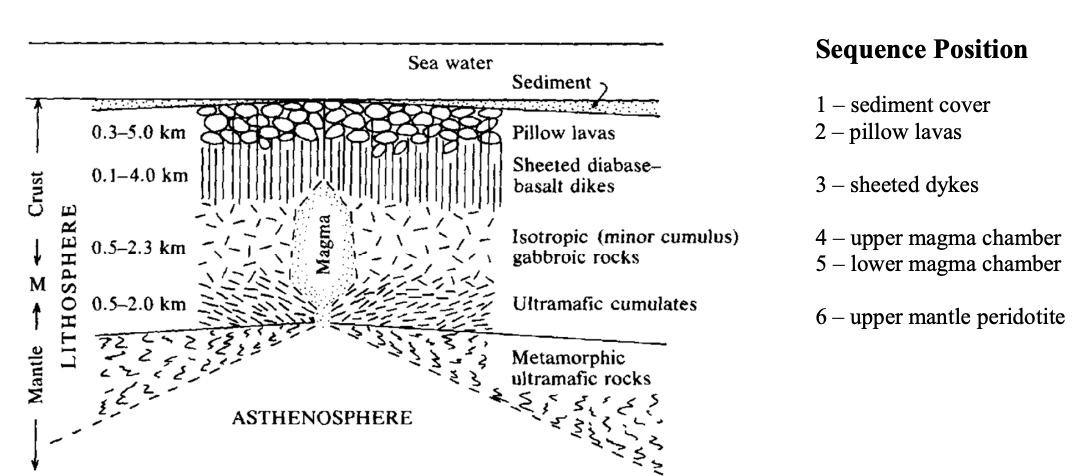Lab 6: Oceanic Crust & Ophiolites
1/32
There's no tags or description
Looks like no tags are added yet.
Name | Mastery | Learn | Test | Matching | Spaced |
|---|
No study sessions yet.
33 Terms
Oceanic crustal rocks are composed of mainly what?
Mafic igneous rocks
basalt at surface
gabbro at greater depths
How do oceanic crusts form?
through a process of stretching (extension), rifting, and rise of mafic magma
as oceanic plates move apart, hot upper mantle rocks partially melt due to decompression melting
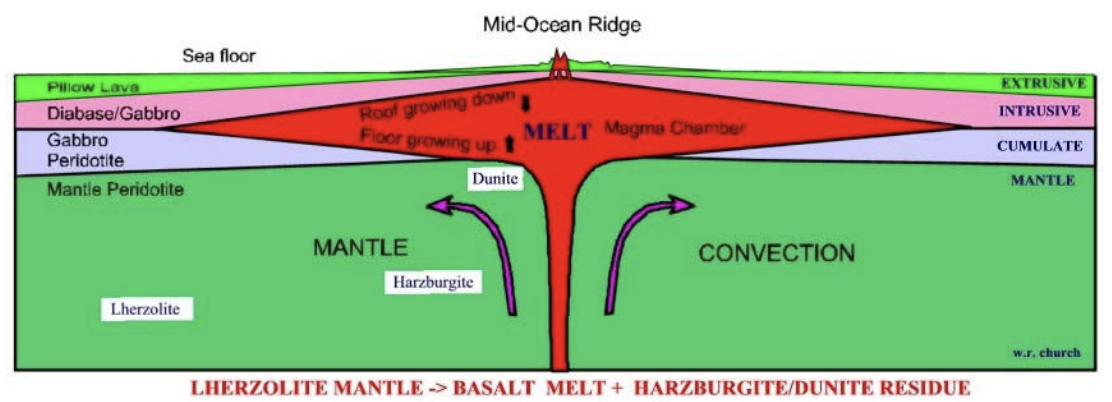
How does basaltic lava occur?
Via faults and fractures at and near the ridge axis, some of the magma reaches the seafloor surface where it erupts as basaltic lava
How are pillow lavas formed?
seawater rapidly cools the basaltic lava as it emerges, quenching it to glass
at low flow rates, thus results in pillow lavas
How is gabbro formed?
dykes have the composition of basalt lava, but crystallize slow producing the phaneritic mafic igneous rock gabbro
Where is diabase formed?
closer to the surface
How are cumulate deposits produced?
as the magma crystallizes, the roof of the magma chamber expands downwards with the addition of newly cooled rock
at the same time the floor expands upwards as crystals of heavy minerals (such as chromite) fall from overlying portions of the chamber and produce cumulate deposits in the lower levels of the magma chamber
The upper cumulate zone - gabbro
represents upper magma conditions
composed of phaneritic mafic rock dominated by Ca-rich plagioclase and pyroxene
This rock is called gabbro
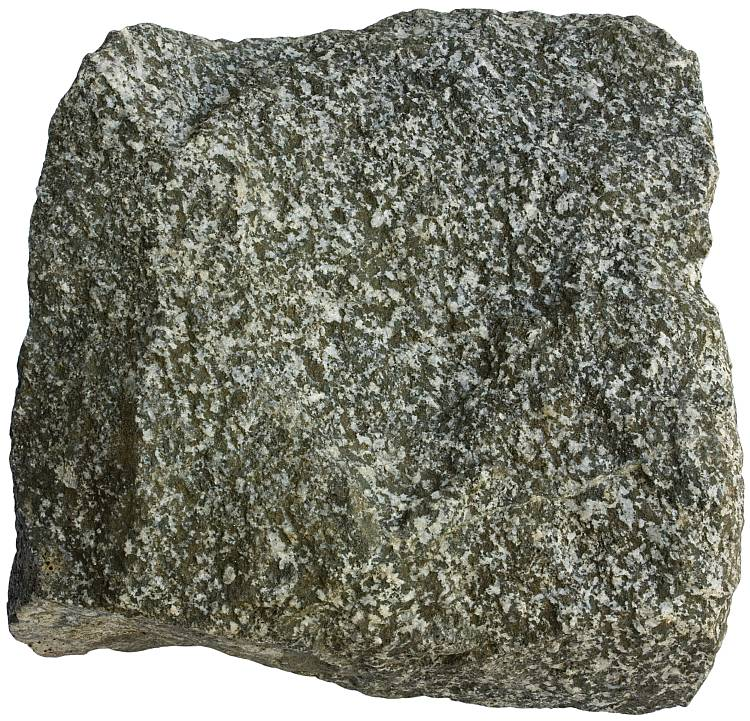
The lower cumulate zone
underlying to phaneritic mafic rocks (gabbro)
represents lower magma chamber conditions
characterized by rocks approaching an ultramafic composition
What underlies the rocks of the crust?
peridotites of the upper (lithospheric) mantle
what is dunite?
a peridotite consisting of more than 90% olivine (or serpentine)
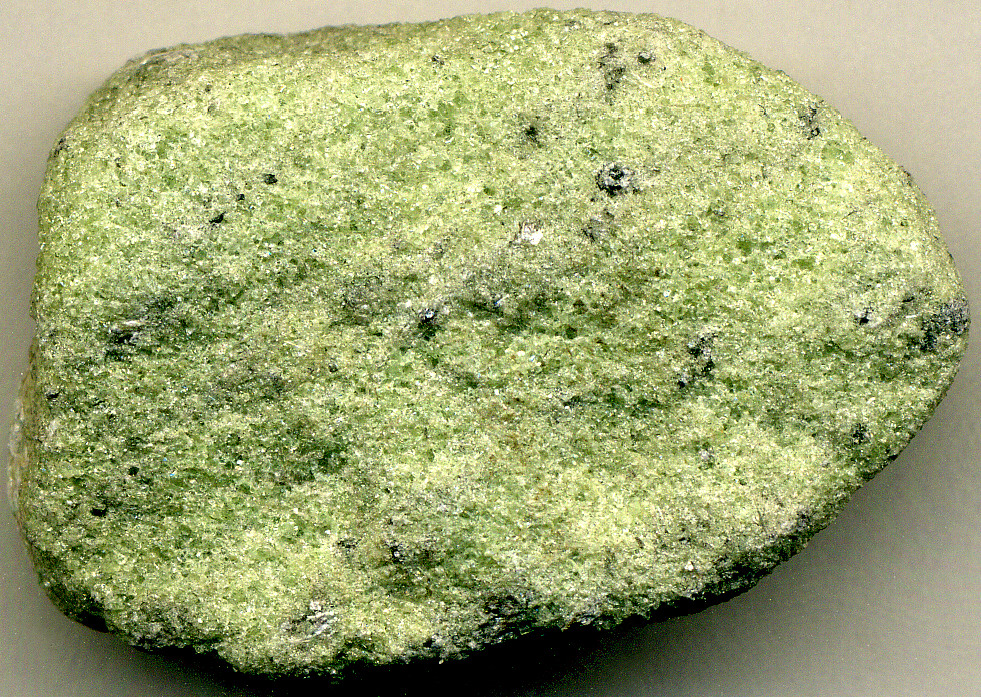
Serpentinized dunite
Orange/brown weathered surface, matte black fresh surface
presence of serpentine (altered from ferromagnesian minerals) indicated by waxy lustre
lack of relict texture suggests that original rock was monomineralic and most likely entirely composed of olivine (and thus would have been massive dunite)
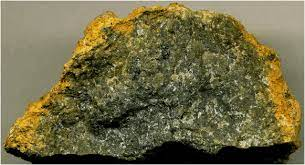
Cumulate gabbro
Dark grey gabbro showing alternations of pyroxene- (black) and plagioclase- (grey-white) rich layers
Phaneritic texture indicates slow cooling at depth
Layering indicates crystal accumulation at the bottom of a magma chamber by episodic gravitational settling of denser crystals (pyroxene) and intervening times of crystallization of less dense crystals (plagioclase)
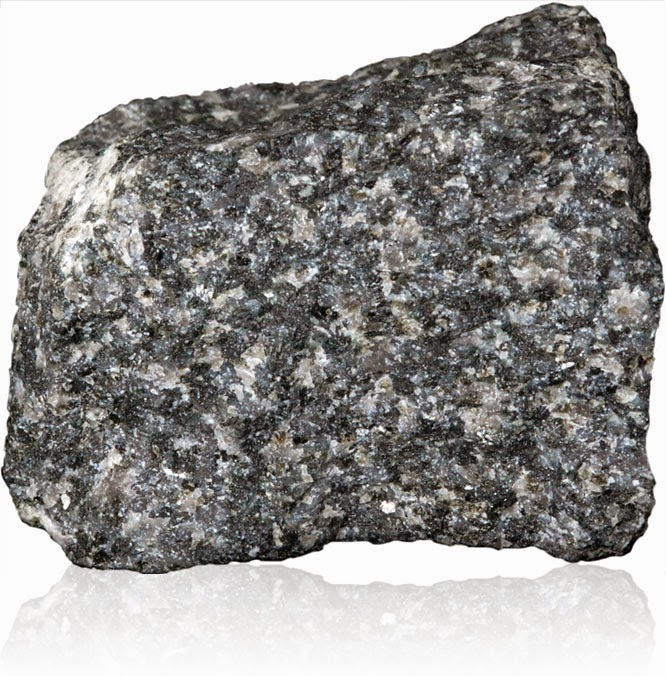
Leucogabbro
Medium grey, medium grained, leucogabbro
mafic phaneritic rock containing 5-40% ferromagnesian minerals (mostly as pyroxene) and dominated by plagioclase (>50% as anorthite)
The greater proportion of plagioclase relative to clinopyroxene imparts a colour that is lighter than for true gabbro (which tends to be dark green/grey to black)
Note that the prefix leuco means “white” Probably represents the upper gabbro layer of the ophiolite
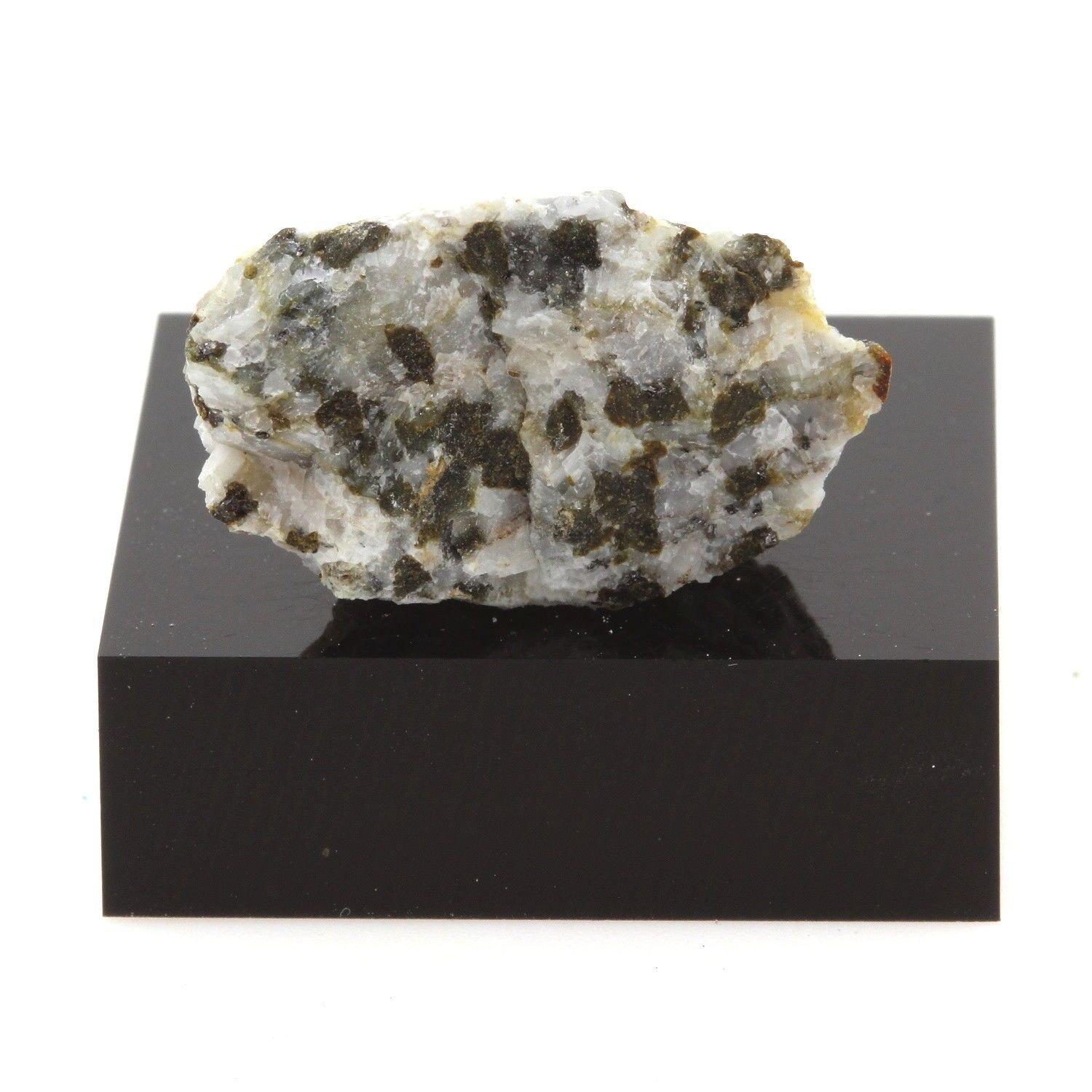
Basalt breccia
Breccia composed of fragments of diabase and assorted aphanitic (nearly glassy) mafic materials in a black basaltic matrix (indicating rapid cooling of lava at the seafloor surface)
the unsorted and angular character of the fragments suggest the brecciation resulted from steam explosions associated with sea-water at or near the seafloor
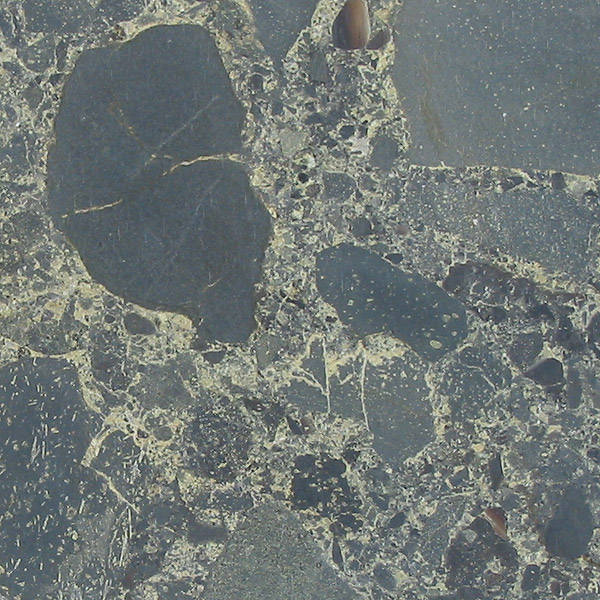
Diabase
Very fine-grained (nearly aphanitic), with tiny, light-coloured, elongated crystals of plagioclase feldspar in a dark green groundmass of ferromagnesian minerals
Probably formed in the uppermost part of a sheeted diabase dyke unit of an ophiolite complex (close to pillow basalt unit)
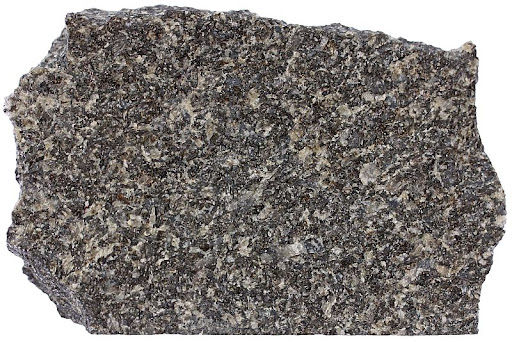
Deep sea sediments
quite fine-grained because far from source
accumulate slowly
majority of these sediments are biogenic/biochemical in origin produced by biological processes or chemical precipitation
4 major types of deep sea sediments
terrigenous muds
calcareous oozes
siliceous oozes
red clays
Terrigenous muds
clays that were suspended in the water column and slowly settle to the deep ocean floor
clay-rich and produce shales and mudstones (fissile - shale, non-fissile - mudstone)
Calcareous oozes
composed of a mixture of foraminiferal material that rains onto the sea floor and precipitated calcite
limestones produced from these oozes are micrite and chalk
Siliceous oozes
sponges produce hard parts containing silica (opal)
the silica settles to the ocean floor
Produces chert
Red clays
consist of mixtures of terrigenous sediments and ocean precipitates
Massive sulphides - Black smokers
pod-like deposits of sulphide minerals associated with black smokers
grey to brassy yellow on fresh surfaces, greenish grey on weathered surface
pyrite, chalcopyrite
direct association with volcanic activity at mid-ocean ridges
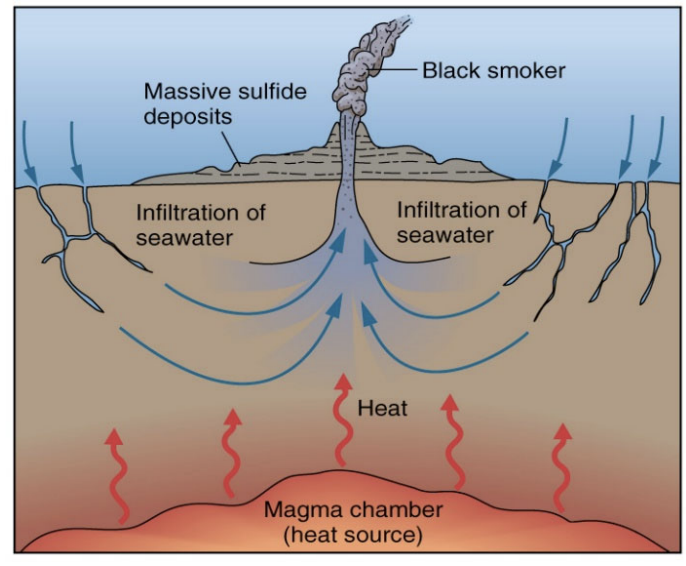
Ophiolites
Sections through the oceanic crust that are now exposed on continents
essentially slices of oceanic lithosphere that have been scraped off during the process of subduction and subsequently been uplifted
they represent oceanic crust that traveled from the mid-ocean ridge to a subduction zone
General sequence for an ophiolite
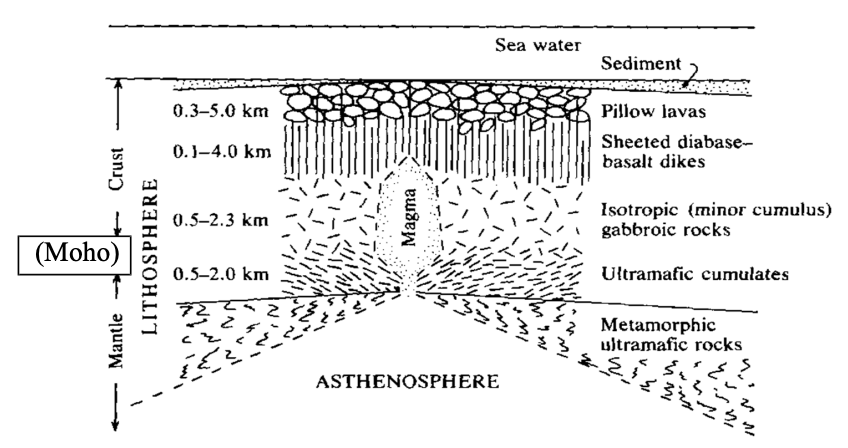
Common alteration minerals observed in mafic to ultramafic rocks:
Serpentinized rock
Formation of talc
Epidotized rock
Amphibolitized peridotites
Hematite (rust)
Serpentinized rock
serpentine is a common alteration mineral for high-temp ferromagnesian minerals such as olivine and pyroxene
a rock containing minerals that have experienced alteration to serpentine is said to be serpentinized
Talc formation
further alteration of high-temp ferromagnesian minerals can lead to the formation of talc
can resemble serpentine in colour (green-black) but is much softer and can be scratched with a fingernail

Epidotized rock
recognizable by pistachio green colour
commonly occurs as an alteration minerals on surfaces of fractures, weathered surfaces or inside vesicles
a rock containing minerals that have experienced alteration to epidote is said to be epidotized
Amphibolitized peridotites
pyroxene can revert to amphibole
peridotites containing these amphibole pseudomorphs are said to be amphibolitize
Hematite (rust)
common weathering product of virtually all mafic to ultramafic igneous rocks
the presence of a yellow/orange/red stain or crust of weathered surface of a rock indicates abundant iron
Amygdules
infilled vesicles
a basalt containing amygdules is called an amygdaloidal basalt
Ophiolite sequence positions
